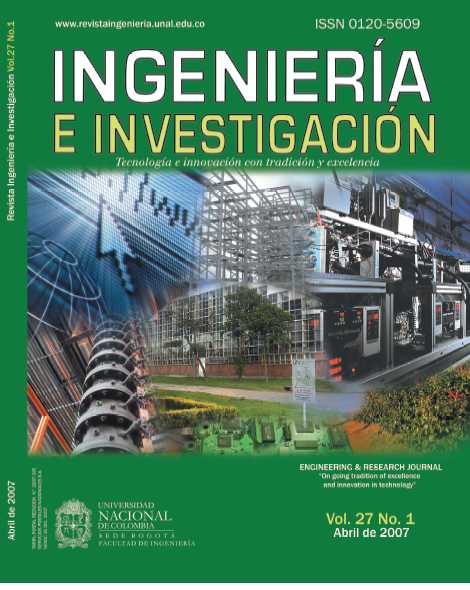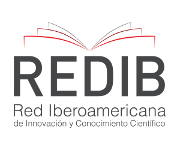Developing an artificial neural network model for predicting concrete’s compression strength and electrical resistivity
Desarrollo de un modelo de redes neuronales artificiales para predecir la resistencia a la compresión y la resistividad eléctrica del concreto
DOI:
https://doi.org/10.15446/ing.investig.v27n1.14771Keywords:
neural network, concrete strength, concrete resistivity, concrete ultrasonic pulse velocity (en)redes neuronales, resistencia a la compresión del concreto, resistividad del concreto, velocidad de pulso en el concreto (es)
Downloads
The present study was conducted for predicting the compressive strength of concrete based on unit weight ultrasonic and pulse velocity (UPV) for 41 different concrete mixtures. This research emerged from the need for a rapid test for predicting concrete’s compressive strength. The research was also conducted for predicting concrete’s electrical resistivity based on unit weight ultrasonic, pulse velocity (UPV) and compressive strength with the same mixes. The prediction was made using simple regression analysis and artificial neural networks. The results revealed that artificial neural networks can be used for effectively predicting compressive strength and electrical resistivity.
En esta investigación se busca obtener un método para predecir la resistencia a la compresión mediante el peso unitario y la velocidad de pulso ultrasónico usando 41 mezclas de concreto diferentes. El estudio ha sido por la necesidad de obtener un método rápido para predecir la resistencia a la compresión del concreto. De la misma manera, la investigación también busca predecir la resistividad eléctrica del concreto mediante el peso unitario, la velocidad de pulso ultrasónico y la resistencia a la compresión. El modelo para predecir se realizó utilizando una regresión simple y un modelo de redes neuronales. Los resultados mostraron que los modelos de redes neuronales para predecir la resistencia a la compresión y la resistividad eléctrica del concreto funcionan adecuadamente.
References
ASTM C 597., Standard Test Method for Pulse Velocity Through Concrete., Annual Book of ASTM Standards, American Society for Testing and Materials, West Conshohocken, PA, Vol. 4.02.
Demuth, H., Beale, M. and Hagan, M., Neural Network Toolbox., For Use with MATLAB®, 2006.
Graham, L. D. Forbes, D. R. and Smith, S., Modeling the ready mixed concrete delivery system with neural networks., Automation in Construction, Vol. 15, No. 5, 2006, pp. 656-663. DOI: https://doi.org/10.1016/j.autcon.2005.08.003
Hilera, J. R, y Martínez, V. J., Redes neuronales Artificiales: Fundamentos, Modelos y Aplicaciones., Castilla Editores, 1997.
Mindess, F. Y. and Darwin, C., Second Edition, Prentice Hall, 2003.
Obert, L., Measurement of pressures on rock pillars in underground mines., R.I. 3521, U.S., Bureau of Mines, 1940.
Portland Cement Association., Electrical Resistivity of Concrete - A Literature Review., PCA R&D, Serial No 2457, 2003.
Ramachandran, V. S. and Beaudoin, J. J., Handbook of analytical techniques in concrete science and technology - principles, techniques, and applications., Edited by Institute for Research in Construction National Research Council, Ottawa, Canada, 1999.
How to Cite
APA
ACM
ACS
ABNT
Chicago
Harvard
IEEE
MLA
Turabian
Vancouver
Download Citation
License
Copyright (c) 2007 Juan Manuel Lizarazo Marriaga, José Gabriel Gómez Cortés

This work is licensed under a Creative Commons Attribution 4.0 International License.
The authors or holders of the copyright for each article hereby confer exclusive, limited and free authorization on the Universidad Nacional de Colombia's journal Ingeniería e Investigación concerning the aforementioned article which, once it has been evaluated and approved, will be submitted for publication, in line with the following items:
1. The version which has been corrected according to the evaluators' suggestions will be remitted and it will be made clear whether the aforementioned article is an unedited document regarding which the rights to be authorized are held and total responsibility will be assumed by the authors for the content of the work being submitted to Ingeniería e Investigación, the Universidad Nacional de Colombia and third-parties;
2. The authorization conferred on the journal will come into force from the date on which it is included in the respective volume and issue of Ingeniería e Investigación in the Open Journal Systems and on the journal's main page (https://revistas.unal.edu.co/index.php/ingeinv), as well as in different databases and indices in which the publication is indexed;
3. The authors authorize the Universidad Nacional de Colombia's journal Ingeniería e Investigación to publish the document in whatever required format (printed, digital, electronic or whatsoever known or yet to be discovered form) and authorize Ingeniería e Investigación to include the work in any indices and/or search engines deemed necessary for promoting its diffusion;
4. The authors accept that such authorization is given free of charge and they, therefore, waive any right to receive remuneration from the publication, distribution, public communication and any use whatsoever referred to in the terms of this authorization.



























